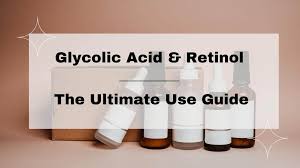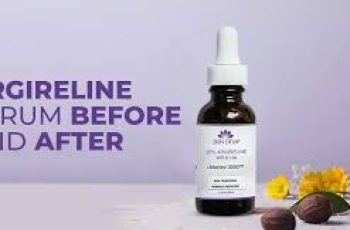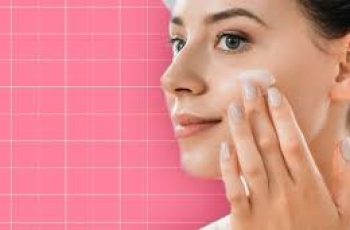
Can You Use Glycolic Acid in the Morning and Retinol at Night? A Comprehensive Skincare Guide
Over the years, skincare routines have become increasingly sophisticated—and, for many, a bit overwhelming.
With so many products and ingredients on the market, some familiar and some sounding more like science experiments, it can be tricky to know what to use and when.
Two of the most popular and effective ingredients that consistently come up are glycolic acid and retinol. Both pack serious benefits for your skin, but many people wonder:
Can you use glycolic acid in the morning and retinol at night? And more importantly, how do you combine them safely?
Today, we’re diving deep into this question. By the end of this guide, you’ll understand how these ingredients work, the best ways to apply them, and tips to avoid irritation. Ready? Let’s go!
Understanding Glycolic Acid: What Is It and Why Use It?
Glycolic acid is part of the alpha hydroxy acid (AHA) family, which are water-soluble acids derived mostly from natural sources like sugar cane.
It’s well-loved for its gentle yet effective exfoliating properties.
By loosening the “glue” that holds dead skin cells on the surface, glycolic acid helps shed dull, flaky skin. This reveals brighter, smoother skin underneath and can improve texture, tone, and overall radiance.
It’s found in many types of products—cleansers, toners, serums, and even moisturizers.
Because glycolic acid penetrates the top layers of skin, it helps encourage cell renewal and stimulates collagen production over time.
If your skin is oily or acne-prone, glycolic acid can be especially helpful in reducing breakouts by clearing pores and controlling excess oil.
It’s a multitasker that suits many skin types, but because it’s an exfoliant, it can increase sensitivity if overused.
Retinol: The Gold Standard for Anti-Aging and Skin Renewal
Retinol is a form of vitamin A and belongs to a larger family called retinoids. It is famed for its powerful anti-aging benefits and its ability to address multiple skin concerns.
Retinol speeds up skin cell turnover, encouraging the shedding of old cells and growth of new ones. This process helps fade fine lines, wrinkles, dark spots, and uneven texture.
Besides brightening and smoothing skin, retinol boosts collagen and elastin production—the proteins responsible for skin’s firmness and elasticity.
It’s widely available in serums, creams, and lotions in various strengths, from gentle over-the-counter formulas to prescription-grade products.
Because retinol can be potent, it’s best introduced gradually to prevent irritation.
Why Use Glycolic Acid in the Morning and Retinol at Night?
Combining glycolic acid and retinol in your skincare routine is a fantastic way to get the benefits of both exfoliation and renewal—but timing is crucial.
Glycolic Acid in the Morning
Using glycolic acid in the morning helps gently exfoliate dead skin cells accumulated overnight. This can leave your skin feeling fresh and radiant as you start the day.
Products like cleansers or toners with glycolic acid are excellent morning picks because they don’t stay on your skin long and prepare your face to absorb moisturizers and SPF better.
Retinol at Night
Retinol must be applied at night because it’s sensitive to sunlight. UV rays can break down retinol, rendering it less effective or even inactive.
Nighttime use allows retinol to work uninterrupted, boosting cell turnover and collagen production while you sleep. It can reduce fine lines, smooth texture, and brighten your complexion over time.
Can You Use Glycolic Acid and Retinol on the Same Night?
Here’s where it gets tricky. Both glycolic acid and retinol are powerful exfoliants that increase cell turnover, but using them together on the same night can overwhelm your skin.
The Risk of Over-Exfoliation
Layering these ingredients without a break can cause redness, dryness, irritation, and peeling. Your skin’s barrier can get compromised, leading to discomfort and sensitivity.
How to Use Them Together Safely
If you want to use both on the same night, timing and product choice are key.
A gentle routine could look like this:
Remove makeup and cleanse your skin.
Apply a glycolic acid toner with a cotton pad.
While your skin is still damp, apply a hydrating serum rich in hyaluronic acid.
After that, layer on your retinol serum or cream.
Finish with a nourishing moisturizer containing ingredients like vitamin E or ceramides to strengthen your skin barrier.
The trick is to apply glycolic acid first, give your skin a moment to absorb and rebalance pH, then follow with retinol and hydration.
However, this method is best for experienced users whose skin tolerates these actives well.
Should You Use Glycolic Acid in the Morning or Night?
Glycolic acid can be used in the morning or at night, depending on your skin’s tolerance and product formulation.
Morning use: Great with cleansers and toners that rinse off quickly.
Night use: Suitable for serums or creams with higher concentrations for deeper exfoliation.
If you’re new to glycolic acid, starting with morning use in the form of a cleanser or toner is a safer bet to monitor skin response.
Always follow with sunscreen during the day, as AHAs increase photosensitivity.
Retinol: Do’s and Don’ts
Retinol is a skincare superstar but must be used carefully to avoid irritation. Here’s a quick guide to maximize benefits and minimize risk.
Do’s
Use only at night.
Start slow—apply once or twice a week initially.
Build up tolerance over weeks or months.
Increase frequency to 2-3 times a week as tolerated.
Gradually move to stronger formulas once skin adapts.
Don’ts
Avoid high concentrations at the start.
Don’t layer with other potent exfoliants without spacing applications.
Never skip morning SPF.
Stop use if you experience persistent redness, dryness, or itching.
Avoid retinol during pregnancy or breastfeeding unless cleared by your doctor.
Why Retinol Is a No-Go in the Morning
Retinol’s sensitivity to sunlight makes morning use ineffective and potentially harmful. Sun exposure can break down retinol molecules, diminishing their potency.
Also, retinol can thin the skin’s outer layer temporarily, increasing the risk of UV damage. Using retinol in the morning without proper sun protection can lead to irritation and long-term harm.
Can You Mix BHA (Salicylic Acid) with Retinol?
Beta hydroxy acids, like salicylic acid, are popular for treating oily and acne-prone skin because they penetrate deep into pores and dissolve excess sebum.
However, mixing BHA with retinol directly is not recommended. Both are exfoliants working differently but intensely. Combining them without careful timing can cause dryness, redness, rashes, and irritation.
If you want to use both, alternate days or use one in the morning and the other at night with caution.
Understanding Your Skin’s pH and Why It Matters
Your skin’s pH is typically slightly acidic, around 4.5 to 5.5. Glycolic acid lowers skin pH temporarily to promote exfoliation, while retinol works best at a neutral to slightly basic pH.
Applying glycolic acid and retinol back-to-back can disrupt pH balance, reducing effectiveness and increasing irritation risk.
Allowing some time between applications or using hydrating serums in between helps restore pH and protects skin.
Tips to Combine Glycolic Acid and Retinol Safely
Introduce each ingredient slowly, one at a time.
Use glycolic acid in the morning; retinol at night.
Start with low concentrations and build tolerance.
Keep skin well-hydrated with moisturizers rich in ceramides, niacinamide, and vitamin E.
Always apply a broad-spectrum SPF 30+ in the morning.
Listen to your skin—reduce frequency or stop if irritation occurs.
Consider consulting a dermatologist for personalized advice.
What About Sensitive or Dry Skin?
If your skin is sensitive or dry, be extra cautious.
Start with gentle glycolic acid formulations or milder AHAs like lactic acid.
Use low-strength retinol or retinol alternatives like bakuchiol, which can deliver similar benefits with less irritation.
Always prioritize hydration and barrier repair, especially when using exfoliants.
Why Hydration and Sunscreen Are Non-Negotiable
Both glycolic acid and retinol can increase your skin’s vulnerability to sun damage and dehydration.
A daily routine that includes a nourishing moisturizer and a high-quality sunscreen is essential. Sunscreen protects your skin from UV damage and prevents photoaging.
Hydration supports the skin barrier, reduces irritation, and keeps your complexion plump and glowing.
Final Thoughts: Is Using Glycolic Acid AM and Retinol PM Right for You?
Using glycolic acid in the morning and retinol at night is a highly effective way to improve skin texture, tone, and youthfulness.
The key is a gradual introduction, careful timing, and supporting your skin with hydration and sun protection.
If you’re new to either ingredient, start slowly, patch test, and watch your skin’s response.
With patience and proper care, this powerful duo can transform your skincare routine, revealing brighter, smoother, and more youthful skin.
Have Questions? Connect With Us!
Skincare can be complex, but you’re not alone! If you want personalized guidance or product recommendations, come find us on Instagram. We love helping you unlock your best skin.
If you’d like, I can help you build a step-by-step personalized routine tailored to your skin type and concerns. Just let me know!


